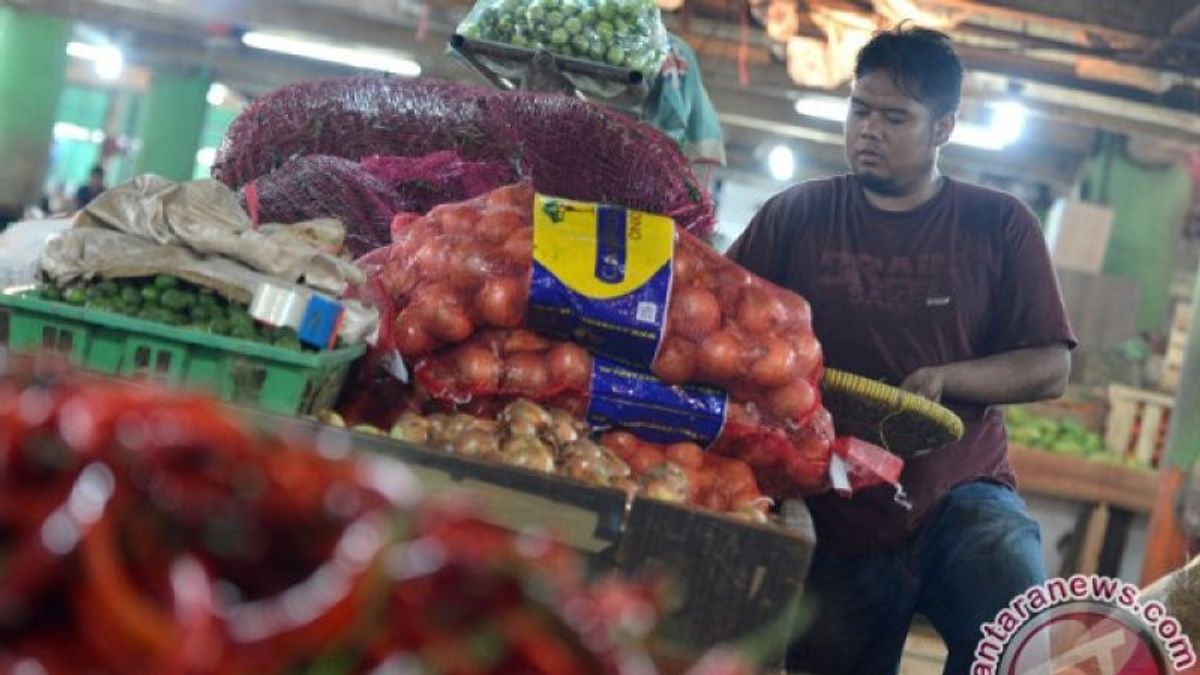JAKARTA – Koes Plus once described in the lyrics of the song Swimming Susu that Indonesia is a paradise land, fish and shrimp can approach, wooden sticks and stones can become plants. But now in the midst of rising staple food prices, are we still optimistic?
The people's patience and purchasing power are being tested by rising prices for several food commodities. Food price fluctuations are still consumed by the mass media and become the talk of the community. The increase in commodity prices that attracted the most attention was cooking oil.
Especially after the government released the price of cooking oil following the market mechanism, which made the price soar. Even though it has been running for several months, the issue of stockpiles and rising cooking oil prices has not found a bright spot.
During the same period, there was also a shortage of other commodities, such as soybeans, beef and chilies. Global scarcity of food, various domestic problems, lack of domestic supply are the reasons for rising prices and scarcity. This condition further suppresses people's purchasing power.
In mid-February 2022, there was a strike for tofu and tempeh producers because the price of imported soybeans had skyrocketed. Soybean prices reached Rp 11,000-Rp 12,000 per kilogram, or an increase of 30-40 percent compared to the price set by the government of Rp. 8500 per kilogram.

The increase in soybean prices was triggered by the limited supply of imports due to bad weather in soybean producing countries. In addition, it is also influenced by the high demand in China for animal feed needs.
Beef is also included in the list of commodities experiencing price spikes. In early March 2022, the price of beef in the market penetrated to Rp. 140,000 per kilogram, compared to the previous price range of Rp. 110,000 to Rp. 120,000 per kilogram.
The main reason is the Australian policy of reducing cattle exports, in an effort to limit the number of cattle slaughtered for repopulation. Because so far Indonesia has only imported cattle from Australia.
Like the story of tofu and tempeh, this increase was also marked by strikes. The impact also extends to a number of derivative businesses such as meatball traders.
The condition of rising prices of basic commodities is getting hotter and hotter, because the price of chili in the market has also doubled. Cayenne pepper was previously in the range of Rp. 35,000 per kilogram, increasing to Rp. 60,000-Rp. 70,000 per kilogram. The price spike was triggered by extreme weather which reduced the supply of chilies. In addition, the scarcity of subsidized fertilizers has discouraged farmers from planting chilies.
Food Insecure ThreatThe rush to increase in droves led to pressure among the people, because the commodities that experienced an increase were people's daily consumption. Community dependence on these commodities is still high, including the need for cooking oil. Commodities such as tofu and tempeh are also difficult to release from the Indonesian people, because apart from protein sources, they are also easy to find at affordable prices.
In March 2020, the BPS National Socio-Economic Survey showed that the average Indonesian consumes 37 pieces of tofu and tempeh in a month. Not only in rural areas, but also in urban areas, people always include these vegetable protein sources in their menus.
Food price turbulence coincides with the COVID-19 pandemic. Many families lose their income which has an impact on vulnerability to food insecurity.

BPS recorded that around 29.12 million people or 14.28 percent of the working age population were affected by the pandemic. There was an average decrease in labor wages of 5.18 percent from IDR 2.91 million per month in August 2019 to IDR 2.76 million in August 2020.
The World Bank survey entitled "Indonesia High-frequency Monitoring of Covid-19 Impacts" found that 13 percent of households reported a worse food shortage, due to a decline in income in the May-August 2020 period. The reduction in income ranges from 35-50 percent across sectors.
This survey is ironic, because Indonesia is rich in natural resource potential. Indonesia is one of the countries with the gift of a very wide expanse of land. According to 2018 World Bank data, Indonesia's total area is 1.88 million square kilometers or 1.4 percent of the world's land area. This figure also brings Indonesia into the list of 15 countries with the largest land in the world, along with China, Russia, the United States, India and Mexico.
Of the total area, a third of the land in Indonesia is used for agriculture. It should be able to meet the food needs of its people and not continue to be faced with the problem of food stock fluctuations.
Food securityPreviously, Indonesia had experienced food shortages. In 2008, there was a shortage of cooking oil as well as tofu and tempeh. The price of cooking oil soared due to the high price of crude palm oil (CPO), as well as in 2011.
Based on the Economist Impact report, the global food security index (GFSI) score in Indonesia in 2021 is at a score of 59.2 (moderate category). The index score fell 2.2 points from the previous year.
In fact, in the first year of the pandemic (2020), the score shows that Indonesia's food security index has reached the good category (61.4). In fact, its value rose by one point compared to the previous year, and was ranked 62 out of 113 countries monitored.
According to a report by the US Department of Agriculture (USDA), food insecurity in Indonesia is high. In 2021, food insecurity in Indonesia will be experienced by 42.2 million people, around 15.7 percent of the population. Among Southeast Asian countries, almost half of the food insecure population is in Indonesia.

This indicates that the food problem in Indonesia is quite serious. Meanwhile, the handling of food security in Indonesia can be said to be inadequate.
On the other hand, food stocks at the global level are also volatile and Indonesia's dependence on food imports is still high. According to the Ministry of Trade's records, imports of Indonesian consumer goods throughout 2021 reached 20.18 billion US dollars, or equivalent to Rp. 284.54 trillion.
Ramadan and Eid al-Fitr are only days away, which always encourages increased demand for all food commodities, including a number of commodities whose prices have skyrocketed.
Indonesia is blessed with fertile land and abundant natural wealth. However, rising prices of basic commodities, food insecurity, and resilience of natural resources are still challenges for the government to realize the welfare of its citizens. This requires the role and commitment of the policy makers in making every decision. Because it is ironic, if Indonesia is blessed with paradise land but it is not used as a food producer.
The English, Chinese, Japanese, Arabic, and French versions are automatically generated by the AI. So there may still be inaccuracies in translating, please always see Indonesian as our main language. (system supported by DigitalSiber.id)









